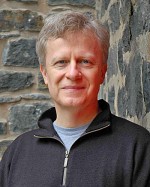Title
There is a great deal we take for granted in the American musical world these days. Command of an instrument is no longer the sole goal of conservatory training; it is now expected that conservatory students graduate with an array of new skills including teaching artistry, collaboration and interdisciplinary partnering, and arts technology. The commitment to developing the artist as citizen, in the words of President Joseph W. Polisi, has deepened the expectations for musicians in today’s world.
Body
Much of Juilliard’s move in this direction has stemmed from the work of Edward Bilous, who has been on the faculty since 1983 and chair of the Literature and Materials of Music (L&M; soon to be called Music Theory and Analysis) department since 1996. He also created Juilliard’s arts and education program; founded its Music Technology Center, in 1997; and started Beyond the Machine, an annual festival featuring the work of students in all three divisions who share interests in technology and collaborations with artists in different disciplines.
Bilous is the recipient of this year’s William Schuman Scholar’s Chair, an honor created in 1998 to celebrate the 50th anniversary of the founding of L&M. It is given annually to a faculty member in recognition of outstanding contributions to Juilliard’s artistic and intellectual life. The recipient gives two lecture-recitals that highlight his or her career and perspective. Bilous’s first lecture, “Reimagining the Arts and Education in the 21st Century,” takes place on April 18 in Rosemary and Meredith Willson Theater; the second will be held in November.
Bilous told The Journal that William Schuman, who was president of Juilliard from 1945 to 1962, “was committed to learning that was not limited to the classroom but [that] would extend out from the practice room into the concert hall.” In 1994, Bilous offered his arts education class, Insights Into Learning, for the first time. It was a requirement for the Morse Fellowship, which also began that year.
Until that time, there were limited opportunities for Juilliard students to give back to the community. One was to perform in a hospital ward or a nursing home for about $200—not bad for a struggling music student. But Bilous saw that there was a tremendous need for more community involvement. Having worked with Lincoln Center Institute for many years, he recognized the importance of dedicated and thorough training for artists if they are to become successful educators, but no such training was available at Juilliard at the time. Indeed, Bilous sensed not only apathy on the part of many students and faculty, but also a disdain for the idea that Juilliard musicians should be trained as educators. He contended, however, that students were being “denied critical opportunities to develop their full creative and intellectual potential” and that “the future of the arts required a new kind of creative engagement with audiences and the community,” he said. So he turned to Polisi for support in beginning an arts in education course at Juilliard.
Bilous wrote in the November 1994 Journal that it was his goal “help our students realize the importance of their role in society. [As the millennium approaches,] aesthetic literacy will emerge as a yardstick by which we measure the educated individual and our students will once again regard the arts as exemplary of humankind’s greatest achievements.”
At the time, I was a second-year graduate student and so one of the first students to take the new course. The curriculum was rooted in encounters with inspiring artists and thinkers such as aesthetic education guru and then-faculty member Eric Booth, new media artist John Toth, musician and music educator Paula Bing, author and improvisational musician Stephen Nachmanovitch, and music-in-education specialist Larry Scripp. I will never forget the experiences I had in that class, which awakened my classmates and me to a new way of thinking about the arts and about our work. One of my classmates from that initial class is graduate studies and L&M faculty member David Wallace (Advanced Certificate ’95, D.M.A. ’99, viola), who said that some of the most important lessons he has learned “came from collaborating with Ed on ‘real-life’ projects.”
Wendy Law (M.M. ’02, Artist Diploma ’04, cello) took a later edition of the class and told The Journal that it was “the starting point of my career as a teaching artist with the New York Philharmonic and arts advocate.” Law, the artistic director of Classical Jam, a quintet created in part to bring classical music to diverse audiences, uses “the philosophy and understanding of arts in education to help establish personal relationships between audiences, performers, and music.”
The course continues to this day. Second-year composition student Yuri Boguinia e-mailed The Journal that “Insights Into Learning blew me away. I had known that teaching was an art—but what an art! Dr. Bilous showed us that being a great teacher is like being a great composer, performer, painter, and poet all in one.” He also noted, “the one thing I found funny about the class was that you learned just as much about yourself as you did about the art of teaching itself.”





